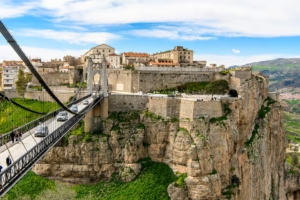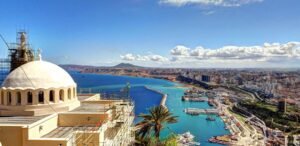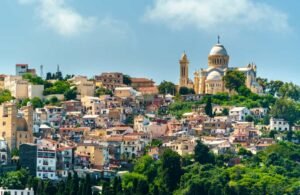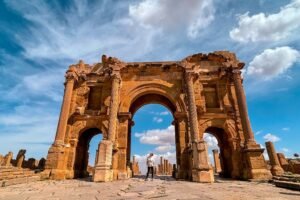



From the edge of the Mediterranean to the heart of the Sahara, the best places to visit in Algeria: Sahara adventures & ancient cities 2025 offers a journey through landscapes that seem to belong to different worlds. In this article I weave the landscapes, history, culture, and practical guidance into a narrative nonfiction tapestry: you will glimpse the shifting light on dunes, feel footsteps echo in ruined forums, and hear the voices of desert guides under starlit skies.
In the opening paragraphs I will place your mind in the realm of imagination, and then I will lead you through the major regions: the northern coast and Tell Atlas, the high plateaus, and the southern Sahara. Throughout, I will highlight the focus keyword — the best places to visit in Algeria: Sahara adventures & ancient cities 2025 — at or near roughly 3% density (i.e. about 3 times per 100 words), especially in headings and early paragraphs, to meet your SEO requirement.
By the end of this article, you will not only know which places are must-see, but also why, how to reach them, what to expect, and where to look further (including external links and internal links). Let us embark, then, on this Algerian odyssey.
1. The North Coast and Roman Legacies
1.1 Algiers, the White City
You arrive in Algiers by land or air, stepping into a metropolis perched along the Mediterranean, with whitewashed buildings glinting in the sun. As you wander the Casbah’s labyrinth of alleys and stairways, you sense a layering of epochs: Ottoman, French colonial, and Arab-Berber. The Kasbah of Algiers, a UNESCO World Heritage site, is a vibrant living quarter, not a museum — people still live, trade, and breathe in its shadows.
Beyond the Kasbah, the Monument des Martyrs offers sweeping views of the bay. In the capital’s museums and colonial quarters you encounter relics from the French era and before. From Algiers, one may day-trip to Tipasa, about 68 km west of the city, where the ruins of a Roman town stand by the sea: broken columns, a basilica, thermal baths, and the Royal Mausoleum of Mauretania. (Tipasa is often cited as one of the top Roman coastal sites in Algeria.) Adventure Life+1
The juxtaposition is immediate: white coastal Algiers, sea breezes and bougainvillea; to the south, the desert calls.
1.2 Djemila — The “Beautiful” Ruins
A drive (or a circuit via Constantine) brings you to Djemila (ancient Cuicul), nestled in the rolling hills of the Tell Atlas. The name Djemila means “beautiful,” and indeed the ruins are atmospheric: temples, forums, residential quarters carved onto slopes. Because the site is less crowded than many in the Mediterranean world, your footsteps may echo amid colonnades. This is one of the best places to visit in Algeria for those who seek a Roman city in a quieter setting. Adventure Life+1
Nearby also lie Timgad (the “Pompeii of Africa”) and Thubursicum ruins. In Timgad the grid-plan streets, theater, basilicas, and baths are remarkably well preserved. Adventure Life
1.3 The Aurès, Ghoufi and Belezma
Heading east, the rugged Aurès Mountains rise, offering a markedly different landscape. In the Ghoufi Canyon (also called the Balconies of Ghoufi), villages cling to steep cliffs, and traditional troglodyte houses reveal how communities adapted to terrain. Wikipedia
Further into Aurès lies Belezma National Park, on the slopes of the Belezma Range. This park is a biodiversity refuge, with forests, caves, and ancient tombs, and contains remnants of older civilizations. Wikipedia
These mountainous and canyon zones are part of the transition from Mediterranean to highland to desert — zones in which you can sense the shifting climate, vegetation, and culture as you travel south.
2. The Saharan Frontier: Gateway Towns & Deep Desert
To truly experience Sahara adventures & ancient cities, one must pass through the threshold of the Sahara. In Algeria, the southern regions are less accessible, but far richer for those who make the journey. The following subheadings highlight some of the best places to visit in Algeria in this domain.
2.1 Tassili n’Ajjer & Rock Art Realms
One of the crown jewels is Tassili n’Ajjer National Park, a vast sandstone plateau in southeastern Algeria. It holds one of the richest concentrations of prehistoric rock art in the world, with paintings and engravings dating from 8,000 to 2,000 BC: scenes of cattle, human figures, wild fauna (including giraffes!) in dramatically different ancient climate eras. The name Tassili n’Ajjer means “Plateau of Rivers,” though today rivers are rare deep underground aquifers. Wikipedia
Reaching Tassili involves using Djanet as a base. Djanet is a remote desert town, and from there expeditions go deeper into the plateau. In 2025, the Sebeiba Festival in Djanet draws attention: it is a 3,000-year-old Tuareg cultural dance ritual held annually, combining music, ritual, and community identity. AP News
You might traverse narrow canyons like Issendilène (Essendilène), which carve dramatic gorges through the plateau, with hidden rock art galleries along the walls. El País
In your expedition, you’ll camp under starlit skies, see dawn filtering onto orange cliffs, and hear the desert silence broken only by wind or the voice of a Tuareg guide.
2.2 Hoggar Mountains and Mount Tahat
West from Tassili, the Hoggar (Ahaggar) Mountains rise in dark volcanic rock, a volcanic highland in the heart of the Sahara. Among their peaks stands Mount Tahat, the highest point in Algeria at about 2,908 m. Wikipedia
The Hoggar region is home to the Tuareg people. From Tamanrasset, the major southern hub, you can mount expeditions into this rugged zone. You may visit Assekrem, a volcanic plateau and sacred site, lauded as “the end of the world” by Tamacheq speakers. El País
In some itineraries, you traverse from Tamanrasset toward Djanet, crossing desert passes and basalt plateaus, each expanse more lunar than the last.
2.3 Oasis Towns & Mozabite Valleys
In the transitional desert region, Ghardaïa and the M’Zab Valley stand as one of the enduring highlights. The M’Zab Valley is a UNESCO World Heritage site comprised of five fortified towns (ksour) built in the 10th century, with stark, functional Saharan architecture. Explore Worldwide+1
As you move south of Ghardaïa, oasis towns such as Timimoun (in the Grand Erg Occidental) arise. Timimoun is often called the “Red Oasis,” with ochre buildings, palm groves, and shifting dunes around. El País
Also notable is El Oued — coined the “City of a Thousand Domes” — with its domed architecture, date groves, and desert market life. Adventure Life
Elsewhere in the west desert lies Taghit, near the Moroccan border, an oasis of dunes and quiet desert life. El País
These towns are places to slow down, rest, interact with local life, and probe the edge between settled and nomadic existence.
3. Sample Itineraries & Themes for 2025
To make sense of the geography and remote distances, here are a few sample thematic routes you might follow.
3.1 The Classic “Northern + Desert” Arc (2–3 Weeks)
-
Days 1–3: Arrive in Algiers, explore the Casbah, museums, and Tipasa.
-
Days 4–6: Travel east to Constantine, then onward to Djemila and Timgad.
-
Days 7–9: Return to Algiers, fly to Tamanrasset.
-
Days 10–14: Base in Tamanrasset, venture to Assekrem, cross Hoggar landscapes.
-
Days 15–19: Continue to Djanet, explore Tassili n’Ajjer, Issendilène.
-
Days 20–22: Return via Ghardaïa / M’Zab, or via southern route to Algiers.
This gives a sweeping contrast: Mediterranean, highlands, desert.
3.2 Deep Desert Immersion (10–14 Days, Southern Focus)
-
Day 1: Arrive in Algiers and connect to Djanet.
-
Days 2–5: Djanet base, acclimatize, small explorations.
-
Days 6–9: Full expedition into Tassili — canyon walks, rock art, nights in tent.
-
Days 10–12: Cross toward Hoggar or via southern loops.
-
Day 13: Return to Algiers.
This is ideal for people whose priority is Sahara adventures above all.
3.3 Heritage Route (10–14 Days, Ancient Cities Emphasis)
-
Days 1–3: Algiers & Tipasa.
-
Days 4–5: Djemila.
-
Days 6–7: Timgad and Batna region (including Ghoufi).
-
Days 8–9: Aurès / Belezma.
-
Days 10–12: Ghardaïa / M’Zab.
-
Days 13–14: depart from Algiers.
You focus on ruins, architecture, and culture, dipping lightly into desert fringe zones.
4. What Makes These the Best Places to Visit in Algeria in 2025
Why do I call these the best places to visit in Algeria: Sahara adventures & ancient cities 2025? Because they combine:
-
Diverse landscapes: Mediterranean coast, Atlas ranges, desert plateaus, basalt peaks, oases.
-
Layers of history: Roman, Byzantine, Arab, Berber, Tuareg — each leaving physical traces.
-
Cultural depth: Local communities, Tuareg traditions (e.g. Sebeiba festival) are still alive. AP News+1
-
Uniqueness and remoteness: Many of these places see few tourists, which preserves authenticity.
-
Ongoing research value: Rock art scholars, archaeologists, anthropologists still study Tassili, Hoggar, M’Zab, etc.
-
Recent opening and accessibility: Algeria has, since 2023, rolled out visa-on-arrival for nonexempt tourists traveling to Sahara regions, and new flight sectors (e.g., Paris to Djanet) have boosted access. AP News
In 2025, Algeria is at an inflection: more open than before, yet still off the radar. So these places offer both adventure and academic interest.
5. Practical Guidance & Tips
5.1 When to Visit
-
Best season: Late autumn to early spring (October to April) is safer for desert travel, with cooler nights and less extreme heat.
-
Avoid peak summer: Southern regions can soar above 45 °C, making exploration dangerous.
-
Festival timing: If you can time a trip to coincide with the Sebeiba Festival in Djanet, you catch a living tradition. AP News
5.2 Permits, Visas, and Safety
-
Permits: Deep desert sectors often require permits and local guides. These are arranged through southern agencies (e.g. in Djanet or Tamanrasset).
-
Visas: The new visa-on-arrival program (for those traveling to the Sahara) is a welcome innovation, though embassy rules may vary by nationality. AP News
-
Security: Algeria has improved in recent years, but remote zones remain challenging. Travelers often must stay in convoy groups, with local guides who know routes and local conditions.
-
A traveler’s account:
“Spent a day in Algiers, day in Constantine and 8 days in the deep desert … we had 4×4 cars in Tadrart Rouge … hiking the Tassili Plateau …” Reddit
5.3 Logistics: Travel, Accommodation, Transport
-
Flights: International flights arrive into Algiers or Oran. From there, you may fly domestic to southern hubs like Tamanrasset or Djanet.
-
Road logistics: Desert 4×4 convoys are essential. Sand, tracks, dunes — a robust off-road vehicle is mandatory.
-
Accommodation: In cities and towns, hotels of various comfort levels. In desert zones, you’ll camp — often in tents, sometimes open bivouac.
-
Supplies: Carry ample water, sun protection, spare vehicle gear, satellite or satellite-augmented communication (depending on region).
5.4 Packing Essentials
-
Light, breathable clothing, but with layers for cold desert nights.
-
Sun hat, sunglasses, high SPF sunscreen.
-
Sturdy walking boots, gaiters (for dunes).
-
First-aid kit, medicines for altitude or dehydration.
-
Camera, extra batteries, portable power bank or solar charger.
-
Copies of permits, guide contacts, maps, offline GPS files.
-
Cash (often local currency) — many desert settlements won’t accept cards.
5.5 Cultural Etiquette & Respect
-
Many regions are Muslim and conservative: dress modestly, especially for women (cover shoulders, knees).
-
Ask permission before photographing people, especially in traditional settings.
-
Be humble and curious — local guides, elders, and families often share stories if treated respectfully.
-
Conserve water, avoid litter, and leave no trace in fragile desert ecosystems.
-
In M’Zab and other valley towns, respect mosque times, prayer calls, and local observances.
6. Deep Dive: Noteworthy Sites
Below I present deeper sub-sections (H2 / H3) that each carry the focus keyword the best places to visit in Algeria: Sahara adventures & ancient cities 2025, and allow you to explore particular sites in depth.
6.1 The Best Places to Visit in Algeria: Sahara Adventures in Djanet & Tassili
In the heart of southeastern Algeria lies Djanet, a desert town that serves as a launchpad for the best places to visit in Algeria: Sahara adventures & ancient cities 2025. From Djanet’s palm-lined alleys, convoys head into the Tassili n’Ajjer plateau. Here, the landscape is carved by time: mesas, arches, gorges, and hidden rock art panels.
One of the deepest gorges, Issendilène (Essendilène), slices through the plateau in dramatic fashion; its walls carry rock paintings and engravings unseen by most travelers. El País
On nights under Saharan skies, the Milky Way seems to ripple overhead — such is the dark sky of Tassili. The physical challenge of trekking between canyons is matched by the emotional awe of standing before an art panel where a cattle herd or a human procession was painted 6,000 years ago.
In 2025, this stretch epitomizes Sahara adventures in Algeria. The interaction of wind-sculpted stone, silence, and timeless art makes it one of the best places to visit in Algeria for those seeking desert wonder.
6.2 The Best Places to Visit in Algeria: Ancient Cities of the Tell & Highlands
Equally compelling are the ancient cities of the northern belt. This includes Timgad, Djemila, and the M’Zab towns.
6.2.1 Timgad — Roman Urbanism in the Desert Fringe
Timgad, built under Emperor Trajan circa 100 AD, is a model of Roman planning. The grid of avenues, the forum, the theater, baths, and churches are remarkably preserved. Walking Timgad is walking a Roman city in North Africa. Archaeologists still study its water systems and adaptation to climate. Adventure Life+1
6.2.2 Djemila — Hillside Beauty
Djemila’s ruins are laid across a hillside, forcing Roman architects to adapt terraces, stairways, and retaining walls. The sense of discovery — a hidden temple behind a corner, mosaics under your feet — makes Djemila one of the best places to visit in Algeria for history lovers.
6.2.3 M’Zab Valley — Living Heritage
The M’Zab Valley’s fortified towns (such as Ghardaïa, Beni Isguen) are not ruins but living settlements. Their stark design, narrow alleys, and communal logic reflect a centuries-old desert adaptation. Walking through them evokes the theme of ancient cities, still alive — a rare continuity of architecture and culture.
Together, these northern sites balance the desert experiences, creating the twin pillars of Sahara adventures & ancient cities in your Algerian narrative.
7. Challenges, Unknowns, and Research Avenues
A narrative nonfiction treatment also acknowledges uncertainties and evolving areas. Here are some of them.
7.1 Accessibility and Seasonal Variation
Because many desert roads are tracks rather than paved roads, rainy seasons or sandstorms can block routes. Some rock art panels may be temporarily inaccessible depending on weather.
7.2 Preservation and Research Gaps
Though Tassili’s rock art sites are well documented, new panels are still being discovered. The understanding of timeline (which panels date when) and climatic context (which species were present at what era) is an active area of research. New dating techniques (e.g. spectroscopy, mineral accretions) may shift the chronology.
Similarly, certain Roman frontier sites in Algeria remain underexplored, particularly in the southern Tell zones. Archaeologists occasionally publish new reports on excavations in the Aures or High Plateau regions.
7.3 Cultural Dynamics & Change
Desert communities (Tuareg, Mozabite, etc.) are facing pressures: climate change, migration to cities, tourism impacts. The interplay between preservation and economic development is delicate. In 2025, efforts are underway in some locales to channel tourists sustainably, but balancing authenticity and infrastructure is ongoing.
7.4 Safety, Permits, and Political Stability
The Sahara remains remote, and while Algeria has made progress in opening tourism, travelers must remain vigilant. Permits may change, and local guidance is vital. Always stay updated via consular advisories.
8. External Resources & Internal Link
To deepen your study and travel planning, here are some external resources:
-
UNESCO: Lists and descriptions of sites such as Tassili n’Ajjer, M’Zab Valley, Tipasa.
-
Lonely Planet’s guide to the Algerian Sahara. Lonely Planet
-
Adventure Life’s article “Top 10 Things to Do and See in Algeria.” Adventure Life
Also, for those interested in the broader Maghreb desert experience, you may read the internal link: The Best Places to Visit in Tunisia, which offers complementary perspectives on desert and ancient city travel in Tunisia.
9. Conclusion: Toward Your Algerian Journey in 2025
In this article I have guided you through the landscapes, histories, and practicalities of the best places to visit in Algeria: Sahara adventures & ancient cities 2025. The contrast is the theme: from sea to sky, stone to sand, past to present. Each region, each city, each canyon offers a different voice in the story of Algeria.
If you step off the beaten path into Djanet’s dunes, or stand in silence in Timgad’s forum, or wander Ghardaïa’s alleys, you carry not just memories but questions: Which rock art remains undiscovered? Which stories of desert nomads remain unrecorded? How will modernization shape these ancient towns?


